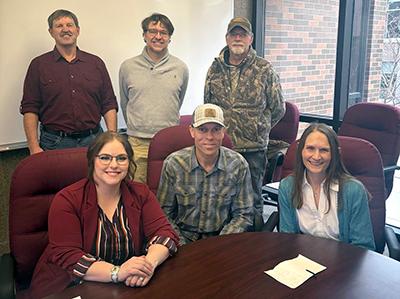Plum River Native Prairie projects adopts a no-till method for restoration

MINOT, N.D. – The Plum River Native Prairie project, formerly known as Erik Ramstad Middle School prior to the Flood of 2011, is embarking on an exciting new journey by embracing the no-till method for restoration.
Following extensive discussions with partners such as the Ward County Soil Conservation Group, Minnesota Native Landscapes (MNL), and Audubon Great Plains, project leaders are confident that this approach will safeguard soil integrity and foster vibrant plant life in the long term.
Here are several reasons behind the decision:
- Preservation of soil structure: No-till farming maintains soil structure, enhancing water infiltration, reducing erosion, and preserving soil fertility.
- Retention of organic matter: By retaining organic matter, no-till farming improves soil health and supports diverse plant life crucial for establishing a native prairie.
- Reduced weed pressure: No-till farming suppresses weed growth by leaving the soil undisturbed, reducing the need for herbicides.
- Preservation of microbial communities: No-till farming preserves soil microbial populations, crucial for nutrient cycling and plant health.
- Conservation of moisture: No-till farming conserves soil moisture by retaining crop residues on the soil surface, reducing evaporation, and improving drought resilience.
- Long-term sustainability: No-till farming mitigates climate change by sequestering carbon, reducing energy consumption, and minimizing environmental impacts.
Overall, the no-till method offers numerous benefits for establishing the Plum River Native Prairie, promoting soil health, biodiversity, and long-term sustainability.
2024 Timeline
🌾 Spring soil testing: Comprehensive soil tests will commence this spring to ensure the project's has a successful foundation.
🌾 Powwow Week dedication: Save the date for April 27 at 11 a.m. for a special land acknowledgment and dedication ceremony during Minot State University’s Powwow Week.
🌾 Summer preparation: Throughout the summer, resources will be devoted to preparing the 14.2 acres of land for the upcoming planting season in the fall.
🌾 Fall planting: Once we have established the appropriate growing conditions, we will plant our first round of seeds with a “no-till drill.”
This journey will span several years, and the project is committed to building a robust foundation every step of the way. Continued support is invaluable, and we eagerly anticipate witnessing the flourishing of this project together.
For more information, contact Dan Conn, Minot State University associate professor, Department Chair of Education and Inclusive Services, by phone at 701-520-9084 or by EMAIL.
For further updates and progress, stay tuned as we work together to make a positive impact on our community and the environment.
About Minot Public Schools
Dedicated to providing quality education and nurturing personal growth in students, contributing to the development of informed, responsible, and compassionate individuals. (WEBSITE)
About Audubon Great Plains
A regional office of the National Audubon Society, working to protect birds and their habitats through conservation, education, and advocacy, striving for a sustainable future. (WEBSITE)
About Ward Soil Conservation District
Engaging with producers in voluntary actions to keep air, water, soil, habitats, pasture, and farmland healthy. (WEBSITE)
About Minnesota Native Landscapes (MNL)
MNL is a full-service ecological restoration company. We provide decades of experience, knowledge, industry leadership, and a variety of services. (WEBSITE)
About Minot State University
Minot State University is a public university dedicated to excellence in education, scholarship, and community engagement achieved through
rigorous academic experiences, active learning environments, commitment to public service, and a vibrant campus life.
Published: 02/22/24


